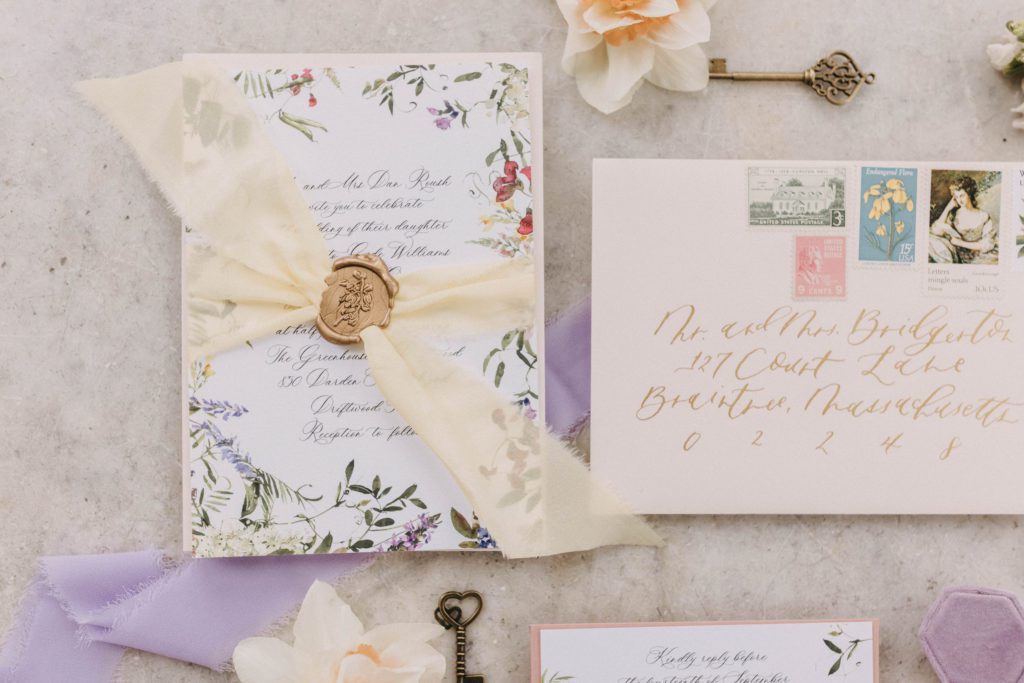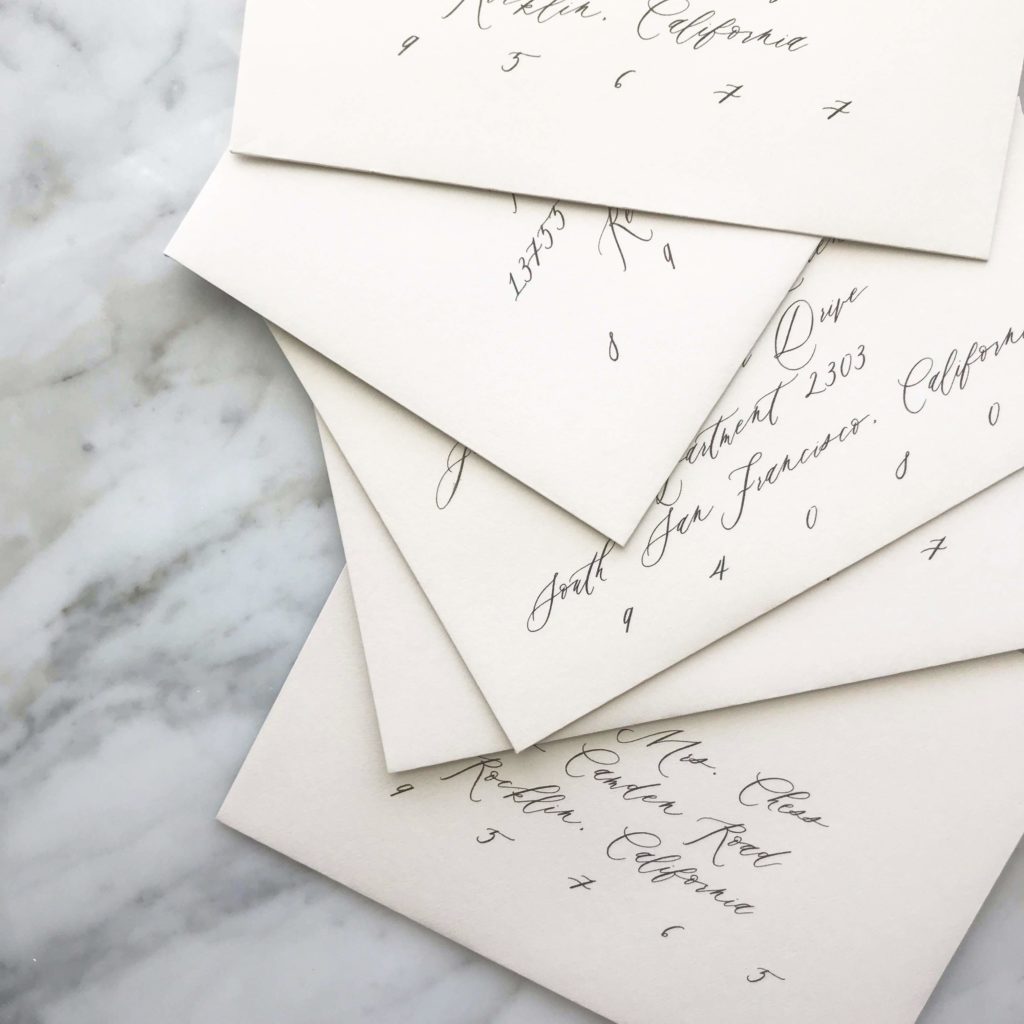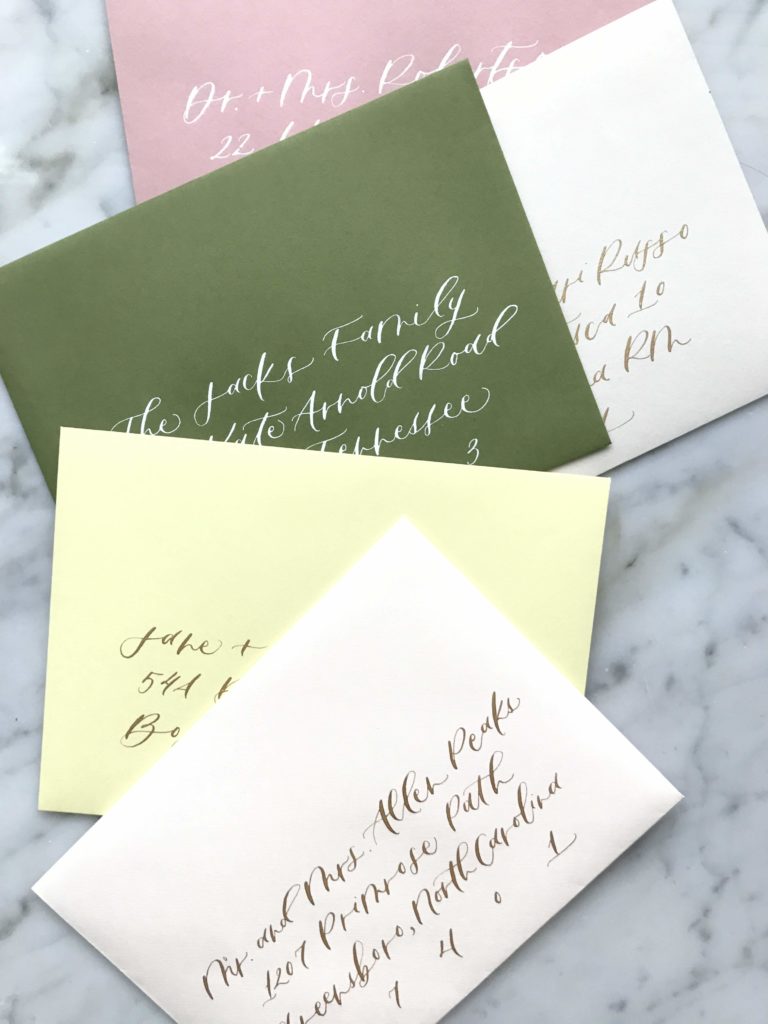Affilate Marketing
All Things Printing
Business Resources
CRMs and Systems
Marketing
Tips & Tricks
Hi, I'm Laney!
I make wedding invitations and I teach artists how to work smarter, make money, and run a business that works for you.
We'd love to have you join us - signup for our email list to get DBL updates, stationery design tricks, business tips and more!
Good morning Mr. and Mrs. Reader! Or is it Ms. Reader? The Drs. Reader? Addressing wedding invitation envelopes can be tricky, confusing, and frankly, not a whole lot of fun (except for some of us crazy enough to do that for a living). Snail mail has declined in popularity, and overall our correspondence has lost some formality over the years. So addressing wedding invitations is one of the times we actually refer to our guests in formal terms.
And because many of us never practice this skill, it’s tough to remember all the right ways to address your guests when it’s time to send out your invitations. So, we have created a guide to wedding invite address etiquette that will make addressing your invites a snap for you and your fiancé when the time comes!

Invitation Addressing Formality
We’d like to note that all addressing etiquette relies on formality. We will be covering the most formal terms and rules here, but feel free to adapt for a more casual or modern wedding! The rules are a lot less strict if your invitation wording and overall vision are a little less traditional.
This is 2021, after all, so you’re generally going to see less traditional wedding invitation wordings, and that can apply to the addressing as well. I have written a full post on how to create your wedding invitation wording too!
Your addressing style in general should match well with the formality of your event, so that guests know what to think about your wedding. If you address everything in an incredibly formal way, and then they show up to a casual style barn wedding, it could be confusing. If you’re not loving the “traditional” address formats, then there are ways to break with that that still communicate different levels of formality.
Addressing Inner and Outer Envelopes
In general, we’ll refer to the addressing of the Outer Envelope in this post. But what are inner and outer envelopes? This practice is less common these days, but for formal weddings it’s still used sometimes. Basically, the entire invitation suite is placed in an envelope and then that envelope (and everything inside) is then placed in a slightly larger envelope. The outer envelope is for mailing and the inner envelope is for protecting the invitation suite.
Wedding Invitation address etiquette tells us to use formal addressing on the outer envelope and less formal addressing on the inner envelope. Usually the inner envelope includes every invitee specifically and uses whatever language you’d refer to that person as in real life.
Example:
Outer envelope: Mr. and Mrs. Jack Conrad Geller
Inner envelope: Mom and Dad / Aunt Judy and Uncle Jack / Judy and Jack
As a note, the inner envelope is also usually “ungummed” meaning it has no adhesive to seal the envelope. It remains unsealed so none of the inside contents get ripped. If you use a decorative envelope liner, it’s best to put this on the inner envelope.
Address Wedding Invitations to Spouses
Spouses are fairly straightforward! The only tricky thing to remember is that a man’s first name should never be separated from his last name. Check it out below:
Formal: Mr. and Mrs. Jack Conrad Geller
Still formal, but less so: Mr. and Mrs. Jack Gellar
Same-Sex: Mr. Chandler Bing and Mr. Joey Bing (Keep both men with their last names, even if last name is the same) or Mr. and Mr. Bing (slightly less formal)
PS: The plural of “Mr.” is actually “Messrs.” so a same-sex male couple would be “Mr. and Mr. Bing” or “The Messrs. Bing”
Same-Sex Less Formal: Monica and Rachel Green / Mrs. and Mrs. Green
For same-sex couples, you can address either person first. We recommend starting with the one you know better, or if you can’t decide, alphabetical order is a good way to go!
Technically, having both spouses’ names in a male/female relationship is not proper – such as “Mr. and Mrs. Chandler and Monica Bing”. It separates the man from his last name, and separates the titles from the right spouse. This is also A LOT on an envelope and can make the spacing tough! If you want both first names to appear, you can use something like “Monica and Chandler Bing” although it’s slightly less formal.
Another one I see sometimes is “Mrs. Monica and Mr. Chandler Bing”. It doesn’t follow traditional etiquette, and is still a lot to put on an envelope, but it’s more correct than the example above as it keeps titles where they should be! Frankly, if you’re set on including female first names, I’d recommend “Monica and Chandler Bing” as it feels more natural.

Address Invitations to Unmarried Couples
This can get a little trickier. If you do not know the name of the guest, simply address your invite and add “and guest” at the end. If you know the name of the guest, then etiquette says to address the man first. Many people these days are listing the person they know best first on the invite, but that is slightly less formal. Still, no matter what, do not separate the man’s first and last names.
Example: Mr. Chandler Bing and Ms. Monica Geller / Mr. Chandler Bing and guest
Is “Guest” Capitalized on a Wedding Invitation?
Had to highlight this one a bit because NO. The word “guest” is not supposed to be capitalized.
Example: Ms. Monica Geller and guest
The word “and” typically represents a romantic involvement, which will be important regarding this next section.
Addressing Wedding Invites to Roommates
Etiquette says that each roommate over the age of 18 should receive their own invitation. If they are family members, you can technically combine them in one invitation, but put each sibling on a different line (to indicate that they are not married). If females are under 18, they are referred to as “Miss” but after 18 they are “Ms.” and men have no title until the age of 16, when they become “Mr.”
This also applies to children still living at home – if they’re over 18, they should receive their own wedding invitation.
If you invite “Mr. Ross Geller and Ms. Monica Geller” it assumes that they are romantically involved (ew). Here’s a better way to do it.
Example:
Mr. Ross Geller
Ms. Monica Geller
Address Wedding Invitations to Families
The most formal way to indicate families on your list is by using only the parents’ names on the outer envelope, and using all of the invitees’ first names on the inner envelope. However, if you are only using one envelope, there are other ways to go about this. Again, anyone over the age of 18 receives their own invitation, even if they still live at home.
If you’re not inviting every child, then you’ll need to distinguish that by including their specific names on the inner or outer envelope.
Example:
Outer: Mr. and Mrs. Bing
Inner: Chandler, Monica, Jack and Erica
With only Outers:
Mr. and Mrs. Chandler Bing
Jack and Erica
OR
The Bing Family
Address Invites with Formal Titles

If either person in a couple has a distinguished title, but their spouse does not have a distinguished title, then the person with the title is listed first, regardless of sex. Titles should not be abbreviated if at all possible.
Example: Doctor Ross Geller and Mrs. Rachel Geller / The Honorable Rachel Geller and Mr. Ross Geller
If both couples have the same distinguished title and share their last name, it is simply pluralized.
Example: The Doctors Geller / The Honorables Geller
If the couple has different titles, you list the one that “outranks” the other first. I’ve had a lot of trouble finding a definitive list of the ranking order, but in general Judge is higher than Doctor, military ranks go by a clear ranking system, and you can honestly make a judgment call if you have some that you’re confused by!
Address Invitations to Divorced Woman
A divorced female can be referred to as “Mrs.” or “Ms.” and by whichever last name she decided to keep after the divorce. In this case, you can just ask!
Example: Ms. Carol Willett / Mrs. Carol Willett
Address Invitations to Widow
A widow typically retains her husband’s last name, and a “Mrs.” title.
Example: Mrs. Carol Gellar (not that we’re fantasizing Ross’s death or anything….)
Address Wedding Invites to Nonbinary People
First and foremost, you can always ask people how they identify and what title they’d like to use. You can also always just use a first and last name for someone if you’d not sure of their title. “Mx.” is a nonspecific gender title and can refer to anyone. However, some people don’t identify with the Mx. title either. Again, you can always ask.
Example:
Mx. Monica Geller
Wedding invite address etiquette can be tricky, but we hope this guide has helped lead you in the right direction and alleviated some stress! Every family is different, and we would not be surprised at all if we missed an example or two! Let us know in the comments below if you have any specific questions or unique invitation situations, and we would be more than happy to assist!
Learn More: Wedding Invitation Wording
Wedding Invite Address Etiquette
Behind the scenes with your favorite Stationery Auntie Laney (and all the inside scoops!)
Not sure where you should start?
I gotchu
Just feeling it out?
Check out our 7 Day Invitation Design Crash Course!
Ready to Start?
Our signature beginner's course From Start to Suite is perfect for you! It's literally *everything* you'll need to get started as a stationer!
Ready to Scale?
Join Stationery School for continuing education with 100+ lessons and new ones released monthly!
[…] Need help formatting your addresses? See our post on that! […]
[…] What envelope color is best? I can’t get over the navy blue envelopes with this one! White ink printing is always an option to help save your hand some addressing trouble (read this Blog Post for some Envelope Addressing Etiquette Tips). […]